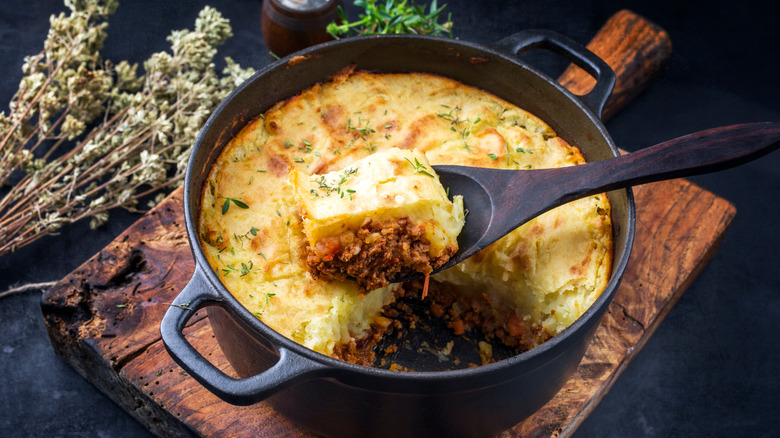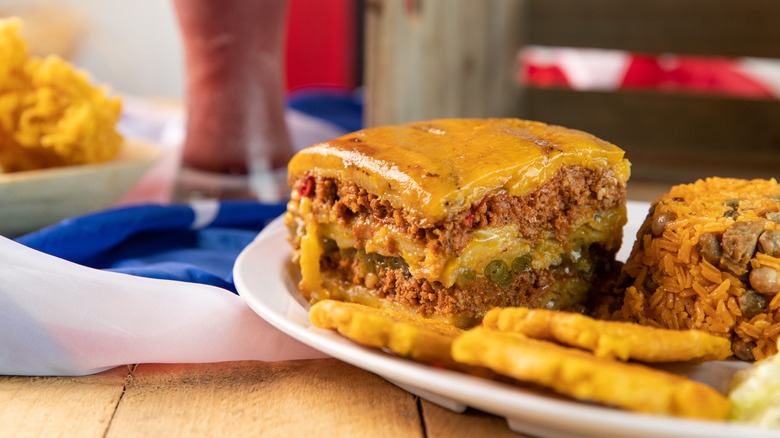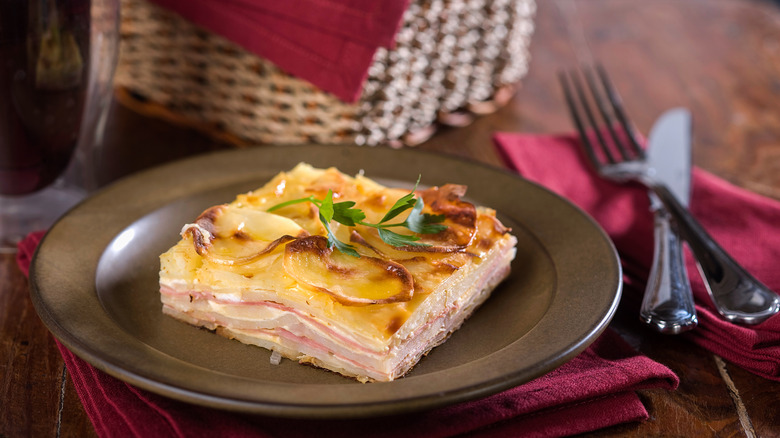Pastel De Papa: The Hispanic Potato Cake Reminiscent Of Shepherd's Pie
The classic shepherd's pie is comfort food royalty. There's something about the savory combination of meat, veggies, and creamy mashed potatoes that ticks all the right boxes. Although the origin of shepherd's pie has been traced to Scotland, this practical and easy-to-make meal is beloved worldwide. Other regions have developed unique versions of shepherd's pie, including pastel de papa, a favorite recipe in South American countries like Argentina, Chile, and Peru.
Pastel de papa is more of a casserole than a pie, and the ingredients, cooking method, and overall look of the dish vary depending on where it's being served. If you know the difference between shepherd's pie and cottage pie (although the terms are often used interchangeably), it's easy to see that, based on its filling, pastel de papa falls under the cottage pie category. Beneath the top layer of mashed potatoes is a mixture of beef seasoned with onions and tomatoes. However, this dish doesn't have the same familiar veggies as shepherd's pie. Instead, pastel de papa often contains a mixture of hard-boiled eggs, raisins, and olives. While this might seem like an unusual flavor medley, the starchy potatoes topped with cheese balance out each bite.
The origin of pastel de papa is disputed
The exact origins of pastel de papa are unknown, but there is speculation that the idea came from Scottish settlers in South America. Argentina has a large Scottish population that has been around since the 19th century. The Scots likely brought their recipes for dishes like shepherd's pie along with them. After a few centuries, these dishes transformed into various regional specialties. Known for producing high-quality beef, Argentina lays claim to pastel de papa as its own culinary invention, but to the west, Chile also takes credit.
Often eaten at family gatherings like potlucks and traditional celebrations throughout the year, pastel de papa is a meal worth sharing. In Hispanic households, it's sometimes viewed as a harbinger of good luck, and every home has its own special recipe. One of the dish's greatest strengths is its versatility, which means there's always room for some tasty experimentation.
How pastel de papa is made in different regions
In a typical Argentinian pastel de papa, the bottom and top layers are made of buttery mashed potatoes (sometimes fried), and the inside is lined with a mixture of beef and special ingredients. The beef is cooked with onions, spices, and tomatoes before chopped hard-boiled eggs, raisins, and olives are added to the pan. However, not all recipes will incorporate the same ingredients. Some swap out the raisins and olives for veggies such as carrots or celery that align more with shepherd's pie. Others might mix shreds of cooked chicken breast or chorizo with the beef. This comfort food can even be wrapped up and served as empanadas, with the savory filling tucked inside a pastry pocket.
Chilean pastel de papa is similar but sometimes calls for one of the country's favorite staples — Panquehue cheese. One of Chile's most popular cheeses, this mild, semi-soft delicacy is produced in the Andes Mountains and will often have red pepper flakes blended in for a spicy kick.
While Argentina's and Chile's pastel de papa variations are the two most common types eaten in South America, Peru's version distinctly differs in presentation and ingredients. Instead of being filled with different meats and veggies, it simply stacks layers of pink or yellow potatoes. Also, only eggs, milk, oregano, and Serrano cheese are added to create a straightforward potato pie.


